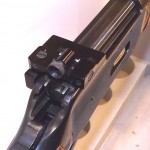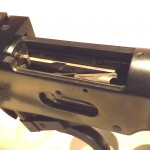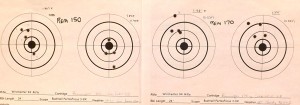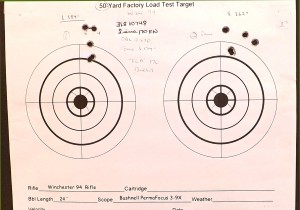For about 118 years the Winchester Model of 1894 has been provoking thoughts in print concerning its various uses and attributes. The need for more thoughts on John M. Browning’s famous creation could thus be rightly questioned, but arms companies, ammo producers, and hunters keep busily plugging away at the gun and the .30 WCF cartridge, and so do the pundits (Ref. 1). Indeed, the gun, the cartridge, and their hunting adventures always seem to be worth some space in the shooting press, so watch out. Here comes my humble dose of thirty thinking.
In context, the Model 94 appeared a bit later than the very successful lever action models of 1886 and 1892, also Browning inventions, which had similar action characteristics and from which the 94 then departed into what would appear to be simpler, perhaps stronger, and more easily manufactured design territory.
If I were recently arrived from another planet and saw a 94 for the first time, I think I would be impressed with its simplicity, but would I judge it to be a “good” design? To ask is heresy, of course. It was designed by The Master, and I am a duffer. So, perhaps we should rather ask how the design of the 1894 differs from that of the Models of 1886 and 1892. The main difference is in the design of the locking mechanism. In the ’86 and ’92, the bolt is locked by two lugs which straddle the rear of the bolt in vertical
fashion and ride in matching vertical grooves in the bolt and receiver. This seems quite an elegant way to lock a lever bolt, and most folks think these arms operate very smoothly. In the Model 94 the single locking lug also rides in vertical receiver grooves, but blocks the full width of the bolt at its rear. In both designs the locking lugs drop out of and rise into locked position by virtue of direct lever attachment.
More than once I have read that the Model 94 action is stronger than that of its predecessors, for it was made using modern steel in anticipation of firing smokeless powder cartridges, but the earlier Browning designs were never thought to be weak. The 86 was chambered for some real blasters, albeit at black powder pressures, and modern Model 92 replicas easily handle cartridges in the .44 and .357 magnum class, albeit they are made of modern steel. Note also that the Model 71, a successor to the Model 86, used a powerful smokeless load, the .348 Winchester, and that cartridge has been wildcatted to produce a number of big-bore blasters using the same action. Some later versions of the Model 94, on the other hand, were chambered for more power with the .307 and .356 Winchesters, cartridges in the 50,000 psi class. So, no real need to question the Model 94’s strength.
My personal opinion, based on experience with seven different .30-30 rifles, is that this cartridge exerts relatively little pressure on the bolt face when fired from a dry chamber. Fired factory ammo of all brands usually comes out of these rifles with the spent primer set back a few thousandths from the case head. In fact, I think you could measure the headspace of your thirty-thirty by comparing lengths of a just-fired empty and a decapped empty. I have not wanted to believe this, but I can’t come up with any other explanation for proud primers.
In case you are not convinced, I will cite an experiment by P. O. Ackley, the intrepid, mid-twentieth-century, wildcatter and experimenter. In investigating performance of rimmed cartridges Ackley once took the locking lug completely out of an old Model 94 leaving the breech block with no support at all. As he tells it: “The rifle was fired several times with the barrel tight. All cases appeared to be normal except for excessive primer protrusion.” (Ref. 2)
Tuning the Model 94 for Accuracy.
One of the common threads running through Model 94 commentary over many long years is that the arm is not very accurate (compared to bolt action guns). Shooters will usually report that groups measuring 2 -3” are obtained at 100 yards, and lucky ones sometimes say 1.5”. These results are almost always reported to be “good enough for hunting,” and experience shows the truth of this. That said and accepted, we can appreciate the Model 94 for its rustic looks, great handling characteristics, and quick followup shots. Nevertheless, 94 lore often seems to contain a quiet, melancholy wish that the gun would lay them in a bit closer together.
Tuning bolt action sporting rifles is a popular pastime among rifle enthusiasts who like to tinker, but design differences prevent most bolt action accuracy techniques from being used with lever guns. Mr. John Wootters, in a chapter on lever guns in a rather high-level gunsmithing publication (ref. 3), makes the following statement (reported here a bit out of context):
“….the various exposed-hammer lever rifles, such as the Winchester Model 94 and the several similar Marlin products, are pretty nearly untunable, in my experience.”
He does follow this thought with the idea that relieving stress caused by tight or ill-fitting barrel bands might be helpful.
Almost thirty years earlier, Helbig and Cain, in an article on lever guns in the 1965 Gun Digest, gave more specific advice (ref. 4). The authors of this article did a lot of accuracy work with a number of lever rifles, including the Winchester Model 88 and the Savage Model 99. Regarding the Model 94, they advise that if a check of the magazine tube shows that it is totally tight, then it probably is in a binding situation with the barrel. When the barrel heats due to firing, additional stress is created and shots will start to walk. The remedy is to prevent any communication of stress between a warming barrel and the magazine tube. To do this one removes the front barrel band, magazine cap, and spring. One then goes to the barrel band at the end of the forearm, which may be so tight as to squeeze the mag tube upward, locking the tube and barrel together at that point. Careful removal of foreend wood at the band position and possibly also a bit from the mag tube channel at the band position, will free the tube of stress with the barrel when the barrel band screw is snugged down. With a tight screw, one should still be able to slightly turn the mag tube in its channel and move it a bit fore and aft fairly easily.
Helbig and Cain state that the front barrel band is even more critical, and they advise reaming or grinding the interior barrel portion for a sliding fit. Then, do not over tighten the band screw. Use LocTite with a snug adjustment. Again, when everything is assembled one should still be able to move the magazine tube fore and aft just a bit. After this work, and a bit of trigger smoothing, These workers reported that a 94 that originally grouped 3.1” with handloads shot 2.2” and gave a best group of 1.5 “ at 100 yards. That was a decent improvement and well worth working for.
Experiences with my Model 94
My version of the classic is a Model 94AE (Angle Eject) made in 1987. It has a 24” barrel, some good black walnut with a bit of figure in the butt, and a smooth, blue-black finish to the metal. The pic shows the action open and you can see the robust
ejector blade at the lower right of the bolt. This setup sends empties out at an angle and allows a scope to be mounted directly over the action. The pic of the end of the barrel shows that this model has a dovetailed ring, rather than a barrel band, to hold the magazine tube at the upper end. A pin through the ring fits in notches in barrel and
tube to keep the tube in place. Note the heighth of the front sight, necessary when using the aperture rear unit. Note also that the screw that holds the magazine tube cap has a stud that extends through the tube into a hole in the barrel. I adjusted the ring for a slip fit of the mag tube. Also, the band at the end of the foreend was relieved so as not to put pressure on the barrel when snugged in place. The mag tube channel in the foreend was rasped a bit to relieve any pressure on the tube when everything is tight.
At one point I got some Weaver bases and mounted a Bushnell 3-9X scope. The rear base needed to be shimmed to level the scope enough to get into the bull. The angle eject worked fine with this setup and the scope did help me get good groups, but in the end I did not like what a scope does to the balance and appearance of the Model 94. I settled on a Williams FP aperture sight that is much less obtrusive than a scope and yet gives good sighting precision with a proper target (See my post “Precision with a Peep: Using an Aperture Sight”)
The 24” barrel is the same length always quoted as being used when factory ammo velocities are listed. As reported in the article Factory Loads for the .30-30 Winchester (See Articles page), this 94 sent 150-gr. bullets from seven factory loads downrange at an average velocity of 2351 fps, and 170-gr. bullets likewise at 2170 fps. These loads included offerings from Winchester, Remington, Hornady, Federal, and Speer. The velocities measured are right on for factory ammo in the two bullet weights. In a later test project, bullets in the Hornady LEVERevolution 160-gr. load emerged from the muzzle of the Winnie at an impressive 2375 fps.
In accuracy, this 94AE has always been pretty good, but a bit unpredictable. It has always shown a preference for the heavier bullets. Data from the article cited above show that four-shot group sizes averaged 3.90 MOA with 150-gr. loads and 2.07 MOA with 170-grain loads. Representative groups are shown in the pic, two 150-gr. groups at left and two 170-gr. groups at right, both from Remington CoreLokt soft point
ammo. These groups show this rifle’s tendency to throw three-and-a-flyer, less pronounced with the heavier bullet. It is true that those of us who use three- and four-shot groups will occasionally be plagued by groups with one flyer, but this is not all bad. Lack of flyers in small groups, when we find it, is a sure-fire indication of a really good load, and then we are happy. The best performance of the 94AE was obtained with Winchester Silvertip 170-gr. pills which averaged 1.48 MOA. Such performance would be very good with any rifle. Unfortunately, this excellent load seems to be no longer available in the .30-30 chambering.
Handloads for the 94AE
I have fired well over 100 groups, many of them five-shot groups, in investigating the performance of handloaded rounds in this 94AE rifle. I have settled on W748 as the best powder for accuracy when using Sierra or Hornady 170-gr. flat point bullets, both of which are very accurate at the usual .30-30 shooting distances. W748 usually gives best accuracy when loaded a bit lower than maximum. A charge of 31.8 grains W748 with the Sierra 170-gr. FP gives 2084 fps average velocity with an extreme spread of only 29 fps and a standard deviation of 14 fps. Two five-shot groups fired with this load are shown in the pic. Upping the charge, and velocity, causes accuracy to fall off a bit. The pressure of a load giving around 2100 fps with 170 grainers in a 24” barrel is about optimum and not much may be gained by going higher. Other powders that also work well with the 170-gr. bullets are IMR 3031 and Alliant RL-15.
Looking to the Future
Do you think the Model 94 has a future? Well, you can still buy a brand new one if you don’t mind that it is made in Japan. Visit Winchester’s web site. I am sure the quality is on a par with those made earlier by Winchester, but I think I will just keep messing around with my 94AE. I have found that it likes 170-gr. bullets, but I have no idea what it would do with a good 180-gr. round nose. There is little info in the literature about loading the .30-30 with such bullets. I think I will find out, maybe using Hodgdon’s LEVERevolution powder, among others. You will probably be able to read about it here some day. In fact, keep your eyes peeled for new articles on the Model 94 and .30-30 in all shooting publications. I guarantee you have not seen the last of them.
(1) See, for example, Van Zwoll,Wayne, “The Thirty-thirty Winchester: Short Magnum for the Frontier,” The Gun digest, 2009 Edition.
(2) Ackley, P. O., Handbook for Shooters and Reloders, Vol. I, Plaza Publishing, Salt Lake City, UT, 1962. p. 147
(3) Wootters, John, “Tuning the Levers,” Gunsmithing Tips & Projects,”Wolfe Publishing Co., Prescott, AZ, 1989. p. 228
(4) Helbig, C.H., and Cain, P.B., “Lever Action Rifles,” The Gun Digest, 1965, The Gun Digest Co., Chicago, IL. p. 198.








